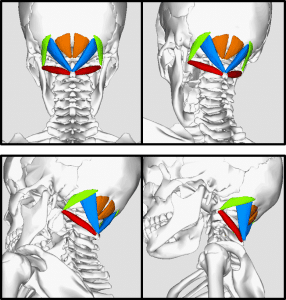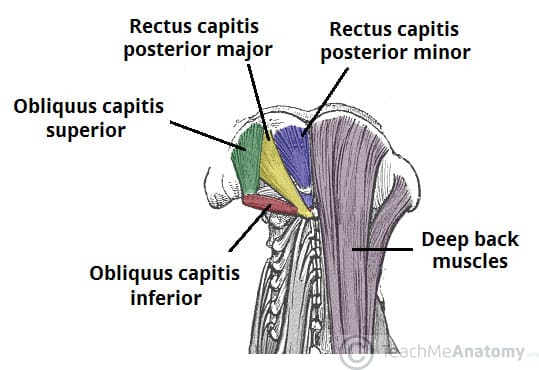
Fig 1. Your suboccipital muscles may be causing you headaches and migraines.
There are many muscles in the neck which support the weight of your head, and help stabilise the very mobile cervical joints.
As seen in the image above, the suboccipital muscles are a group of four muscles located on each side of the upper cervical spines, just below the base of the skull. The muscles connect the skull with the top two vertebrae (C1 and C2) of the neck.
The suboccipital muscles
| Muscle | Origin | Insertion |
| Rectus capitis posterior minor | Posterior tubercle of C1 | Medial part of inferior nuchal line |
| Rectus capitis posterior major | C2 spinous process | Lateral part of inferior nuchal line |
| Obliquus capitis superior | C1 transverse process | Occipital bone (between superior and inferior nuchal lines) |
| Obliquus capitis inferior | Posterior tubercle of C2 | C1 transverse process |

Fig 2. Suboccipital muscles (http://teachmeanatomy.info/neck/muscles/suboccipital/).
These suboccipital muscles (muscles under the occiput) play an important role in not just the aforementioned functions, but also in controlling movements of your head and neck, provide sensory input and are also linked closely to vestibular and balance functions.
Symptoms?
However, when the suboccipital muscles become tightened, symptoms may occur. These could include:
- Headaches with a band of pain on the side of the head that extends from the back of the head to the eye. This type of pain feels deeper in the head, and often it is difficult to describe
- Migraines
- Stiff neck (usually painless)
How can you help me?
Here at the Brisbane Headache and Migraine Clinic, our headache clinicians pay close attention to your suboccipital muscles.
Highlighted in red is the Obliquus Capitis Inferior muscle. This muscle is carefully examined as it is usually under spasm and guards in those with headaches and migraines due to a disc disturbance found between the 2nd & 3rd Cervical spine.
Our clinicians will carefully assess this through our comprehensive yet safe assessment procedure. They also examine other muscles around the head, neck and thoracic spine. These include:
- Deep cervico-cranio flexors
- Trapezius
- Sternocleidomastoid
- Levator Scapulae
Management
Your headache clinicians may provide with some advice regarding your posture, any activity/work modifications, and self-management strategies to help manage your symptoms. With the aims of relieving headaches and migraines, manual therapy to the upper cervical spines will most likely be provided. The clinician may also prescribe some exercises to help with decreasing the tension in your head and neck muscles. Together, these will help reduce the intensity, duration and frequency of your headaches and migraines.
Ultimately, the management of your symptoms will depend on the subjective and objective assessments (patient interview and physical examination). Consult a headache clinician today to help you.
Contact the Migraine experts today
Contact us
Contact our headache clinicians for a careful assessment and early diagnosis of your condition.
[email protected] ![]() 1800HEADACHE (1800 43 23 32 43)
1800HEADACHE (1800 43 23 32 43)
Imagine a life free from headaches ![]()
![]()
![]()
Reference
Thewellnessdigest.com. (2017). Suboccipital Muscles: Headaches, Migraines, Eye Pain – The Wellness Digest. [online] Available at: http://thewellnessdigest.com/suboccipital-muscles-headaches-migraines-eye-pain/ [Accessed 14 Oct. 2017].
TeachMeAnatomy. (2017). The Suboccipital Muscles. [online] Available at: http://teachmeanatomy.info/neck/muscles/suboccipital/ [Accessed 14 Oct. 2017].









